
Red Funnel, the trading name of the Southampton Isle of Wight and South of England Royal Mail Steam Packet Company Limited, is a ferry company that carries passengers, vehicles and freight on routes between the English mainland and the Isle of Wight. High-speed foot passenger catamarans, known as Red Jets, run between Southampton and Cowes, while vehicle ferries run between Southampton and East Cowes.
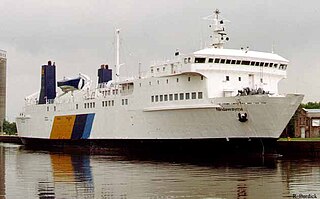
The MV Manx Viking / Nindawayma was a passenger, truck and car ferry, whose last active service was on Lake Huron, operated by the Owen Sound Transportation Company; under contract to the Ontario Ministry of Transportation. In Canadian service she served the Highway 6 route between Tobermory and South Baymouth, Manitoulin Island from 1989 to 1992 alongside the MS Chi-Cheemaun.

HMAS Jervis Bay was a roll-on/roll-off passenger and vehicle ferry operated by the Royal Australian Navy (RAN) between 1977 and 1994.

The Caledonian MacBrayne fleet is the largest fleet of car and passenger ferries in the United Kingdom, with 34 ferries in operation, 2 on charter and another 6 on order. The company provides lifeline services to 23 islands off the west coast of Scotland, as well as operating routes in the Firth of Clyde.

The Port of Southampton is a passenger and cargo port in the central part of the south coast of England. The modern era in the history of the Port of Southampton began when the first dock was inaugurated in 1843. The port has been owned and operated by Associated British Ports since 1982, and is the busiest cruise terminal and second largest container port in the UK. The volume of port traffic categorises Southampton as a Medium-Port City globally.

The MSIlmatar was a cruise ship operated by Palm Beach Cruises as Palm Beach Princess on casino cruises out of the Port of Palm Beach in Riviera Beach, Florida. She was built in 1964 by Wärtsilä Hietalahti shipyard, Helsinki, Finland for Finland Steamship Company as Ilmatar. From 1970 until 1974 and again from 1978 to 1980 she was marketed as a part of Silja Line fleet. In 1973 she was lengthened at HDW Hamburg, Germany by 20.04 m. Between 1975–1976 she was chartered to Finnlines. In 1979 she was converted to a cruise ship.

MS Golden Princess was a casino cruise ship owned by Eurasia International, operated on short casino cruises out of Hong Kong. She was built in 1967 by the Wärtsilä Hietalahti shipyard in Helsinki, Finland as Finlandia for the Finland Steamship Company. In 1975 she was sold to Finnlines, who converted her into the cruise ship Finnstar in 1978. In 1982 she entered service for Pearl Cruises as Pearl of Scandinavia. In 1988 she was renamed Ocean Pearl. In 1994 she entered service with Croisières Paquet as Pearl. Between 1995 and 1998 she sailed for Costa Cruises as Costa Playa. In 1998-1999 she sailed as Oriental Pearl for Mega Wave International, and in 1999-2000 as Joy Wave for Costa Cruises. In 2000 she was sold to Eurasia International and entered service under the name Golden Princess. In 2009 she was sold for scrap to China.

MV Red Eagle is a Raptor-class vehicle and passenger ferry operated by Red Funnel on their route from Southampton to East Cowes on the Isle of Wight. The largest of its class, Red Eagle is the current flagship for Red Funnel.

MV Red Osprey is a Raptor Class vehicle and passenger ferry operated by Red Funnel on their route from Southampton to East Cowes on the Isle of Wight. She was built by Ferguson Shipbuilders in Port Glasgow.

MV Red Falcon is a Raptor Class vehicle and passenger ferry operated by Red Funnel on their route from Southampton to East Cowes on the Isle of Wight. She was built by Ferguson Shipbuilders in Port Glasgow.

MV Pioneer is a stern / side loading ferry built in 1974, in service for 29 years covering nearly all of Caledonian MacBrayne's routes. She now serves the islands of São Tomé and Príncipe in the Gulf of Guinea and was chartered to rescue Liberian refugees.

MV Orion is a ro-ro passenger and vehicle ferry. Saturn was operated by Caledonian MacBrayne in the Firth of Clyde in Scotland between 1978 and 2011, for the first decade of her career on the Rothesay crossing. Later, she also saw service on the Dunoon and Brodick crossings, as well as on short cruises around the Clyde.
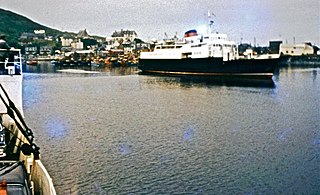
MV Clansman was the second of a trio of hoist-loading car ferries built for David MacBrayne Ltd in 1964 and operated on the Mallaig to Armadale, Skye route for ten years. Converted to ro-ro operation, she operated on the Stornoway, Isle of Mull and Arran services. Underpowered and troubled by mechanical breakdowns, she was taken out of service after 20 years.

MV Arran was a pioneering Firth of Clyde vehicle ferry introduced by Caledonian Steam Packet Company in 1953. She spent fifteen years on the Upper Clyde crossings, followed by five years at Islay. Initially hoist-loading, via side ramps, these were replaced by a stern ramp in 1973. During her final years with CalMac, she relieved across the network. Several unsuccessful attempts were made to turn her into a floating restaurant, before she was scrapped in 1993.
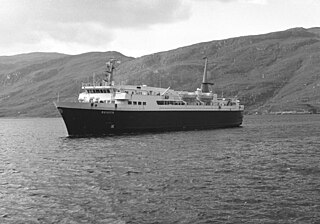
MV Suilven was a vehicle ferry built in 1974 and operated for 21 years by Caledonian MacBrayne on the Ullapool to Stornoway route. She subsequently operated in New Zealand and later in Fiji.
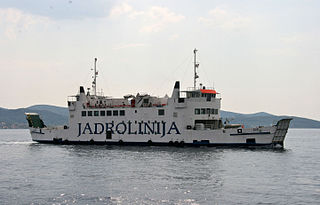
Sis is a car / passenger ferry owned and operated by Jadrolinija in Croatia, where she operates between Zadar and the island of Ugljan. The vessel was previously known as Netley Castle when operated by Red Funnel on services to the Isle of Wight in the UK.
PS Gracie Fields built in 1936, was the last paddle steamer built for Red Funnel as a ferry and excursion steamer. She ran on the Southampton-Cowes route until the outbreak of World War II, when she was requisitioned and served as HMS Gracie Fields as a minesweeper. After successfully evacuating troops from the Dunkirk beaches, she was seriously damaged by an aircraft bomb on 29 May 1940, and sank the following morning.
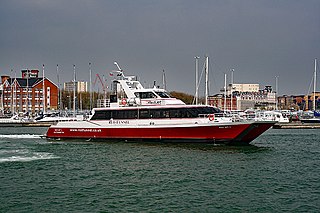
Red Jet 1 was a high speed catamaran passenger ferry operated by Red Funnel between Southampton and Cowes on the Isle of Wight. She was built by FB Marine in 1991 and was the first waterjet propelled craft to operate on the route.
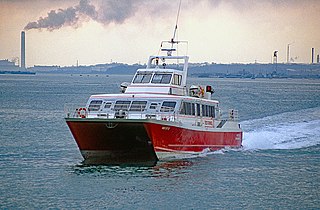
Red Jet 2 was a high speed catamaran passenger ferry operated by Red Funnel between Southampton and Cowes on the Isle of Wight. She was built by FB Marine in 1991. She is identical to her sister ship, Red Jet 1.

MV Norris Castle, the third vessel in the Red Funnel fleet to carry the name, was built in 1968 by John I. Thornycroft & Company at Woolston and operated as a car ferry between Southampton and East Cowes until 1994. Mrs Joan Lacon, owner of the namesake building, Norris Castle, named the ship. Originally designed to load and discharge through the bows, in 1976, she was converted to drive through operation, with mezzanine decks and an extended superstructure, by Boele in Rotterdam. As built, she was 191 feet 3 inches (58.29 m) long with a capacity of 734 GT. After rebuilding she was extended to 221 feet 2 inches (67.41 m) and 999 GT.



















